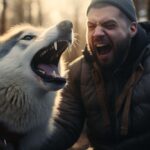Let’s Talk Husky: The Pretty, Popularity, and Personality
Oh, you’ve clicked on this article. That means you’re either already a Husky enthusiast or on the cusp of falling in love with these magnificent canines. Either way, buckle up, friend! We’re about to embark on a thrilling sled ride through the snowy history and captivating allure of Huskies.
Did you know that Huskies are as old as the hills? Okay, maybe not that old, but they’ve been around for a few thousand years, working their fluffy tails off, pulling sleds in the snowy Siberian and Alaskan wilderness. But these dogs aren’t just a pretty face and a dazzling pair of blue eyes. No, sir! They didn’t rise to Instagram stardom just for their looks. Well, not only for their faces. Huskies are also known for their vibrant personality and friendly demeanor. They’re like that one friend who’s drop-dead gorgeous and lights up any room they walk into. You know the type, right?
So, stick around, whether you’re here because you’re already madly in love with these dogs or you’re just Husky-curious. We’re about to delve deeper into the world of Huskies – a world filled with beauty, charm, and more than a bit of fur. Alright, who am I kidding? A lot of hair. But trust me, it’s worth it!
Understanding the Husky Breed
Oh, Huskies. Those piercing blue eyes, thick coats, and an energy level that could rival a toddler on a sugar high. They’re the canine embodiment of the Energizer Bunny, only they look more majestic. But let’s dive deeper into the world of Huskies, shall we?
The Genetics and Traits of Huskies
Huskies, I’d like you to meet everyone. Everyone, meet the Huskies. Now, you might think you know all there is about this breed. After all, they’re just like any other dog but with a better winter wardrobe, right? Well, not quite.
You see, Huskies are bred for the cold. Their genetics gave them a double-layer coat, perfect for those chilly Siberian nights. They also have this unique trait of changing their metabolism, which sounds like some superhero power, but it’s their body’s way of performing for prolonged periods without food. Neat, huh?
Not to mention, they’re incredibly social. Leave them alone too long, and they might start a neighborhood howl-fest. And trust me, no one wants a canine version of karaoke at 2 AM.
Common Myths about Huskies
Now, let’s debunk some myths about our furry friends. Firstly, no, they’re not part wolf. That’s like saying I’m part Neanderthal because my great-great-great (you get the gist) grandparent was one.
Next, Huskies are not aggressive. They’re just overly enthusiastic and have a love for life that’s on steroids. But with proper training, they’ll be as well-behaved as a British royal guard.
And finally, they’re not only for cold climates. Sure, they’d probably prefer a snow-filled winter over a hot summer day, but they can adapt to warmer temperatures correctly. Just remember to crank up that air conditioning and keep them hydrated!
Health Concerns and Lifespan
Now, onto the serious stuff – health concerns and lifespan. Huskies are generally a healthy breed, which is a big plus. But like any breed, they’re prone to specific health issues. For Huskies, it’s hip dysplasia, eye conditions, and sometimes skin issues. Not the most glamorous of health problems, but with regular vet checks and a healthy lifestyle, they can lead a fulfilling life.
Speaking of life, Huskies have a decent lifespan, averaging 12-15 years. That’s a lot of years filled with walks, howls, and endless games of fetch. So, if you’re considering welcoming a Husky, be ready for a long-term commitment. But trust me, it’s worth it.
And there you have it, your crash course on understanding the Husky breed. Remember, owning a Husky is not just about dealing with their high energy levels; it’s about understanding and appreciating their unique traits. After all, in the words of a famous dog lover, “The more I learn about people, the more I like my dog.” So, let’s raise a bone for our Husky friends, shall we?
Exploring Different Types of Huskies
Let’s go on a doggy journey, paw-friends! Today, we’re diving into the fluffy, snowy world of Huskies. We’ll explore three main types, each with their quirks and characteristics. So, let’s put on our snow boots, grab a warm coat, and jump right in!
Siberian Huskies: The Cold-Lovers
First stop, we’re heading to the chilly landscapes of Siberia. Here, we find our first Husky type, the Siberian Huskies. These cold-lovers are like the snow bunnies of the dog world. They’re the ones who’d willingly jump into a snow pile and make doggy snow angels.
Siberian Huskies are recognizable by their dense coat, striking blue or multi-colored eyes, and energetic personalities. They’re like the energizer bunnies of the canine kingdom, always ready for a run or playtime. If you’re considering adopting a Siberian Husky, prepare for some serious exercise, my friend. Trust me, these pups have more energy than a puppy on a sugar rush!
Alaskan Huskies: The Wilderness Pro
Next, we’re off to the vast expanses of Alaska, home to the Alaskan Huskies. These guys are the survivalists of the dog world. You want them on your team when you’re lost in the woods (or when you can’t find your way home from the dog park).
Unlike the Siberian Huskies, Alaskan Huskies aren’t a breed per se. They’re a mix of species carefully selected for their endurance and speed. These dogs are like the marathon runners of the dog world, often used in sled dog racing. If you plan to adopt an Alaskan Husky, prepare for long hours of play and a dog that can outrun you on your best day.
Malamutes: The Heavyweight Champions
Finally, we’re rounding off our Husky tour with the Malamutes. Now, these guys are the bodybuilders of the Husky family. They’re built for strength and endurance, hauling heavy loads in harsh conditions. They’re like the doggy version of your gym-obsessed best friend, always ready to show off their muscles.
Malamutes are larger and heavier than the other Husky types and, with their thick, fluffy coats, are like cuddly teddy bears (with a lot of strength). Don’t let their tough exterior fool you, though. These dogs are known for their friendly nature and love of people. If you’re planning to bring a Malamute into your home, get ready for a lot of love, fur, and strength!
And there you have it, folks! Our little snow-dusted tour of the husky world. There’s a Husky for everyone, whether you’re a fan of the cold-loving Siberians, the endurance-champ Alaskans, or the solid and cuddly Malamutes. Just remember to pack your snow gear!
Decoding the Husky Behavior
Hello there, fellow Husky enthusiasts! Welcome to our cozy corner of the internet, where we delve into the quirks and charms of these mischievous furballs. Today, we’re cracking the Husky code – strap in; it will be a tail-wagging ride!
Husky Temperament: Are they stubborn?
Ah, the age-old question. Are Huskies stubborn or just misunderstood? Now, if you’ve ever tried to reason with a Husky over whether it’s time to come inside (spoiler alert: it’s never time to go inside, according to them), you might be tempted to slap the ‘stubborn’ label on them faster than a Husky can chase its tail.
But here’s the twist: Huskies aren’t stubborn – they’re spirited! These dogs are brimming with personality, a relentless sense of adventure, and an independent streak a mile wide. If a Husky were a person, they’d be that adventurous friend who’s always up for a spontaneous road trip or a late-night taco run. They’re not being defiant – they’re just marching to the beat of their drum (or chasing their tail if you will).
Understanding Husky Vocalizations: Talkative or just vocal?
If you’re not a Husky owner, you might think they’re part dog, part opera singer. From howls to yips, grunts to groans, Huskies have a vocal range that would make Pavarotti green with envy. But what’s all the noise about?
Well, Huskies are the life of the party – they love expressing themselves and joining in on the conversation. Whether they’re telling you about their day, arguing about dinner time, or singing the song of their people at 2 a.m., Huskies are just chatty Cathies. So, it’s not about being vocal – it’s about being social. Remember, in Husky language, silence isn’t golden; it’s suspicious.
Husky Exercise Needs: Energizer bunnies in disguise?
Here’s the deal: Huskies have energy levels that could power a small city. These dogs might seem like they’ve swallowed an Energizer battery (or ten), but that’s just their nature. Bred to pull sleds across vast snowy landscapes, Huskies are built for endurance and need a way to burn off all that pent-up zip.
So, are they Energizer bunnies in disguise? Unless your bunny can pull a sled over a tundra, Huskies have them beat. They need regular exercise to keep their bodies healthy and their minds sharp. Without it, they’re prone to becoming bored and a bit husky.
So there you have it, folks, a glimpse into the fascinating world of Huskies. Remember, understanding your Husky isn’t about decoding their behavior; it’s about appreciating their unique personalities and joining them in their adventures. After all, life is never dull when you’re living with a Husky!
Living with a Husky: What to Expect
Welcome to the beautiful, wacky world of Husky living! If you’re expecting a life of calm, quiet solitude, you’re barking up the wrong tree. But if you’re ready for adventure, laughter, and a few “did that just happen?” moments, you’ve found the perfect furry companion.
Huskies and Apartment Living: A feasible match?
Are huskies in an apartment? It’s more plausible than you might think! These energetic pups can adapt to any environment, even if it’s a fifth-floor walkup. But remember, Huskies are the marathon runners of the dog world. They need plenty of exercise, so be prepared for lots of walks, runs, and games of fetch. And bear in mind if you live in a tropical climate, Huskies might struggle with the heat due to their thick coats.
If you’re an apartment dweller who’s an early riser, enjoys the great outdoors, and doesn’t mind turning your living room into an obstacle course from time to time, a Husky could be your perfect match. If not, consider a less active breed. Or invest in a good pair of running shoes!
Huskies and Other Pets: Friends or Foes?
Now, let’s talk about Huskies and other pets. Are they the best of friends or sworn enemies? Well, it’s a bit of both. Huskies are pack animals, so they get along well with other dogs. Their high prey drive makes them too interested in smaller pets like cats, rabbits, or guinea pigs.
If introducing a Husky to a household with existing pets, do so slowly and carefully. And only leave your Husky alone with smaller animals once you’re sure they get along. Remember, that cute little bunny might look like a delicious snack to a Husky!
The Husky Diet: Carnivore or Omnivore?
What’s for dinner? If you’re a Husky, the answer is “Meat, please!” These dogs are naturally carnivores, so a diet rich in high-quality protein is essential. But that doesn’t mean they can’t enjoy a few fruits and veggies as treats. Apples, carrots, and blueberries can make healthy snacks for your Husky.
But before you start cooking up a storm for your furry friend, remember that not all human foods are safe for dogs. Always research before introducing a new food into your Husky’s diet. And when in doubt, consult your vet.
Living with a Husky is a unique, rewarding experience. Yes, there will be challenges. Yes, there will be moments when you question your sanity. But at the end of the day, when your Husky curls up beside you and looks at you with those loving, ice-blue eyes, you’ll know it’s all worth it. So buckle up and enjoy the ride!
Training and Socializing Your Husky
Hello, fellow Husky enthusiast! Welcome to the exciting, sometimes challenging, but always rewarding Husky training and socialization world. You’ve probably heard that training a Husky is like trying to persuade a cat to fetch: near impossible. Well, I’m here to tell you that it’s possible and can also be a fun and bonding experience. Let’s jump into the snowstorm together, shall we?
House Training: Mission possible?
Ah, house training. You might think it’s impossible, but trust me, with a Husky, it’s more like a mission ‘I-possible.’ Huskies are intelligent and quick learners. But they’re also independent and a bit stubborn. It would be best to channel your inner Ethan Hunt here: be patient, consistent, and creative.
Start by setting up a routine for your furry friend. Like us humans, Huskies love a schedule: regular meals, bathroom breaks, and playtimes. Remember, consistency is key!
Use positive reinforcement. Whenever your Husky does their business outside, celebrate it like they’ve just won the Doggy Olympics. Treats, praises, belly rubs – the works! Before you know it, your Husky will be house-trained, and you’ll wonder why you doubted them (or yourself).
Obedience Training: An essential or an option?
Now, let’s talk obedience training. Some might ask, “Is it essential?” To which I say, “Is a snowstorm necessary for a Husky?” Absolutely! Obedience training is not just about teaching your Husky to sit or stay. It’s about building a trusting relationship between you and your dog.
Huskies are naturally independent and can be a little headstrong (I mean, wouldn’t you be if your ancestors were sled dogs in the Arctic?). But with positive reinforcement and patience, you can teach your Husky to be obedient and well-mannered. Remember, it’s not a one-day job. It’s a fun journey filled with laughs, a few facepalms, and a lot of ‘Good boy’ or ‘Good girl.’
Socializing Your Husky: Party animal or lone wolf?
Finally, let’s dive into the world of Husky socialization. Now, Huskies are known to be friendly and outgoing, but every dog, like every human, has its personality. Some Huskies might be the life of the dog park, while others might prefer a quiet walk with their favorite human.
The key to successful socialization is to start early and expose your Husky to various experiences, environments, and creatures (both two-legged and four-legged). A well-socialized Husky is a happy Husky.
So, there you have it, fellow Husky lover! Training and socializing your Husky might seem daunting, but remember, it’s a journey filled with joy, laughter, and furry cuddles. So, put on your snow boots and get ready to dive into the beautiful blizzard that is life with a Husky!
Adopting a Husky: The Ultimate Guide
Hello, fellow Husky enthusiasts! Let’s get down to the fluffy business of adopting a Husky, the Siberian stunner that could charm the socks off a snowman. Adopting a Husky is not just getting a pet; it’s inviting a whirlwind (with fur) into your life. So, buckle up!
Considering Adoption: Rescues, Shelters, or Breeders?
First, where do you find your bundle of Husky joy? Rescues, shelters, and breeders are all valid options, but each has its own pros and cons.
Rescues and shelters are the doggy equivalent of treasure chests. You’ll find a mix of purebreds and mutts, puppies and seniors, all with unique stories. Plus, you feel like a superhero, rescuing a pup needing a loving home.
Breeders, however, are the go-to choice if you’re after a pup with a pedigree. Remember, though, not all breeders are created equal. Seek out reputable ones who prioritize the health and well-being of their dogs. And folks, if they don’t let you meet the puppy’s parents, run like your Husky spotted a squirrel!
Preparing for a Husky: Checklist for a happy homecoming
Now, onto the fun part – prepping for your Husky’s arrival. Think of it like preparing for a mini, fur-coated, four-legged hurricane. Huskies are full of energy, so toys (lots of them!) are a must.
Remember a comfy bed, food and water bowls, a leash, a collar, and a crate for training. And remember, Huskies are escape artists. A secure yard is a must unless you fancy playing ‘catch the Husky’ at all day hours.
Life After Adoption: The first few weeks with your Husky
Congrats! You’ve survived the adoption process, and now you’ve got a Husky looking at you with those ‘what’s next?’ eyes. The first few weeks are crucial for setting boundaries, so consistency is critical.
Huskies are more intelligent than the average bear (or dog, in this case). They’ll test your limits, so stay firm. But also, remember to shower them with love and playtime. After all, a tired Husky is a well-behaved Husky.
Also, get ready to turn into a fur magnet. Huskies shed like it’s their full-time job. A good vacuum and a sense of humor will come in handy.
In the end, adopting a Husky is a wild, rewarding ride. They’re loving, playful, and full of personality. So, sit back, relax, and enjoy the Husky-filled adventure you’re about to embark on.
After all, who needs a quiet, fur-free life when you can have a Husky?
Key Traits of the Various Types of Huskies
| Key Trait | Details |
|---|---|
| Diversity in Types | Huskies come in several types, including the Siberian Husky and Alaskan Husky, each with unique physical characteristics and traits. |
| Siberian Huskies | Known for their striking blue or multi-colored eyes, Siberian Huskies are a pure breed recognized by the American Kennel Club. They are friendly, outgoing, and great family dogs. |
| Alaskan Huskies | Alaskan Huskies are a mixed breed designed for work, particularly for sled-pulling. They are not officially recognized as a breed and have a wider range of appearances. |
| Physical Traits | Huskies typically have a dense coat, erect triangular ears, and engaging eyes. They are medium-sized dogs with a high energy level. |
| Temperament | Huskies are known for their friendly and gentle demeanor. They are also highly energetic and playful and require regular physical activity. |
| Health Considerations | Huskies are generally healthy but prone to certain conditions like hip dysplasia and eye disorders. Regular vet check-ups are recommended. |
| Training and Exercise | Huskies require consistent training from an early age. They also need plenty of exercise and mental stimulation due to their high energy levels. |
| Care and Maintenance | Their thick double coat requires regular grooming, particularly during shedding seasons. They are also known for escape artist tendencies, so a secure environment is crucial. |
| Husky Mixes | There are various popular husky mixes, such as the Huskador (Husky-Labrador mix), Huskypoo (Husky-Poodle mix), and the Horgi (Husky-Corgi mix), each combining the traits of Huskies with other breeds. |
So, there you have it – a beginner’s guide to Huskies. It’s a world of laughter, love, and lots of fur. But trust me, it’s a world you’ll never want to leave.






